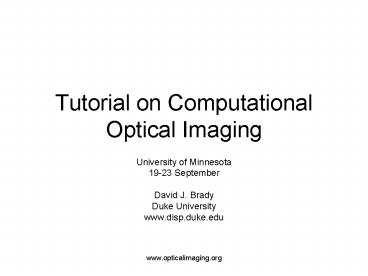Tutorial on Computational Optical Imaging PowerPoint PPT Presentation
1 / 37
Title: Tutorial on Computational Optical Imaging
1
Tutorial on Computational Optical Imaging
- University of Minnesota
- 19-23 September
- David J. Brady
- Duke University
- www.disp.duke.edu
2
Lectures
- Computational Imaging
- Geometric Optics and Tomography
- Fresnel Diffraction
- Holography
- Lenses, Imaging and MTF
- Wavefront coding and focal plane sampling
- Interferometry and the van Cittert Zernike
Theorem - Optical coherence tomography and modal analysis
- Spectra, coherence and polarization
- Computational spectroscopy and imaging
3
Lecture 7. Inteferometry and the van Cittert
Zernike Theorem
- Propagation of Coherence
- The van Cittert Zernike Theorem
- Interferometric Imaging
4
Propagation of the Cross Spectral Density
5
Incoherent Input Distribution
6
Free Space Propagation
7
Coherence Increases on Propagation
8
Imaging Modalities
Improved sensors and processors are breaking down
the differences between imaging in the radio,
optical and x-ray spectra. AFOSR support for
phase sensitive optical detectors has enabled
optical imaging without lenses.
9
Literature
Marks, D.L., et al., Visible cone-beam tomography
with a lensless interferometric camera . Science,
1999. 284 (5423) p. 2164-2166 Marks, D.L., R.A.
Stack, and D.J. Brady, Three-dimensional
coherence imaging in the Fresnel domain. Applied
Optics, 1999. 38(8) p. 1332-1342.
10
History
11
(No Transcript)
12
Mutual Intensity Radiated from an Incoherent
Source Distribution
13
Far Field van Cittert Zernike Theorem
14
Fresnel Zone van Cittert Zernike Theorem
15
(No Transcript)
16
(No Transcript)
17
(No Transcript)
18
Measurement of Coherence Functions
Incoherent source distributions gain coherence on
propagation. Detecting this coherence allows
source reconstruction.
19
Michelson Stellar Interferometer
20
Band Volume
21
Interferometric Imaging
Rotational Shear Interferometer
RSI Design
D. Marks, R. Stack, D. Brady, Applied Optics, 38,
pp. 1332-1342(1999)
22
Recovery of I(r,w) from G
beam splitter
90º shearing mirror
camera
90º dither mirror
translation platform
input aperture
- Sample over the coherence length of the
source. - Resample the data from to
- Fourier transform to get
23
What does the RSI measure?
The field on arm 1 is
The field on arm 2 is
24
Intensity on the RSI Sensor Plane
25
Data Collected by the RSI
Longitudinal Pixel Scan
Spatial Map of Transform Data
Fourier Transform of Pixel Scan
26
Reconstructed Image
27
RSI DATA
2 point sources
Experimental Mutual Intensity
28
Other Examples of RSI Reconstructions
Using path delay in one arm of the RSI,
wavelength information can be obtained, as in
this composite color image.
Image contains two objects, one of which is on
the aperture of the RSI, the other of which is 1
meter away.
High depth-of-field
29
Why use an RSI?
An infinite depth of field image.
30
3D Imaging
31
(No Transcript)
32
(No Transcript)
33
(No Transcript)
34
4D Coherence Imaging
Example 3
556-581 nm
609-640 nm
35
Interferometric Telescopes
http//planetquest.jpl.nasa.gov/index.cfm
36
Interesting Mathematical Issues
- Coherence functions fully describe the optical
field from boundary conditions, but are not easy
to measure. The intensity every where in a volume
also fully characterizes the field. What is the
best measure in terms of minimal error in
estimation and minimal sampling?
37
Measuring W without Measuring W
Daniel L. Marks, Ronald A. Stack, David J. Brady,
Digital Refraction Distortion Correction with an
Astigmatic Coherence Sensor, Applied Optics-IP,
Volume 41, Issue 29, 6050-6054 (October 2002)
Marks, D.M., R.A. Stack, and D.J. Brady,
Astigmatic coherence sensor for digital imaging.
Optics Letters, 2000. 25(23) p. 1726-1728.

